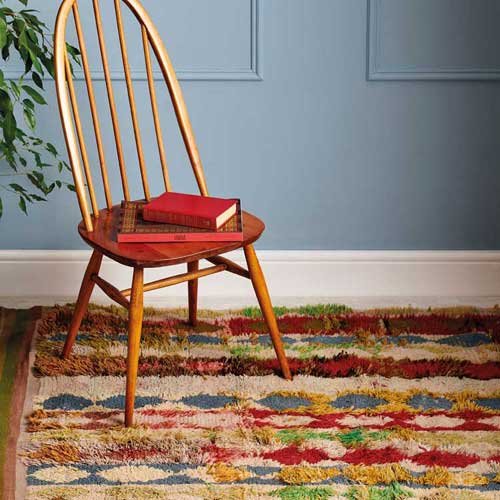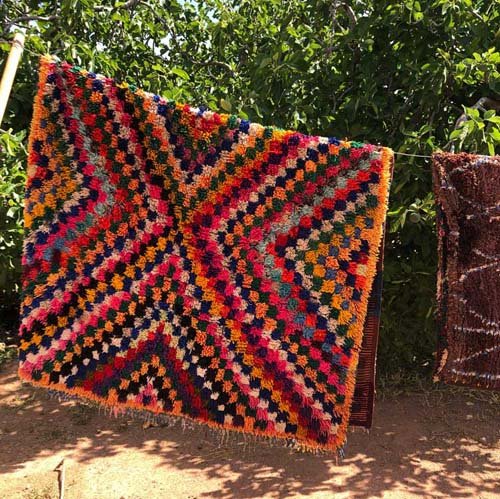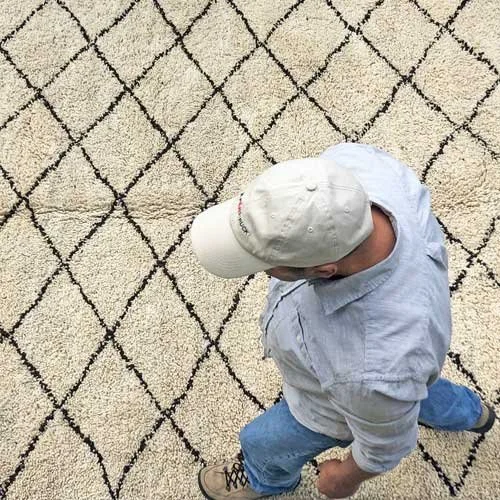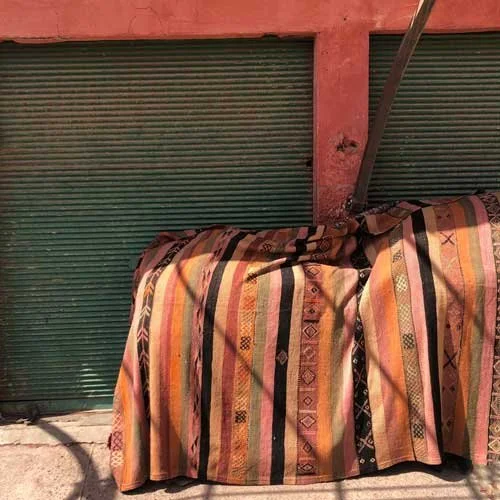Your guide to buying vintage and antique Moroccan rugs
Moroccan rugs continue to be popular across most home decor styles, enlivening interiors with their plush textures and skillfully executed compositions, often appreciated as abstract modern art
Provided you pick the right rug. Because along with their lively reputation has sadly come a slew of fakes, new rugs marketed as old pieces, poor advice, and rugs that are not authentic. Old Berber rugs - those eccentric, artistically interesting carpets - deserve recognition and buyers deserve to know that what they are buying is credible and true
So, how do you find an authentic Moroccan rug?
What is vintage?
The term vintage is these days widely used to describe a whole host of rugs. To us, it mostly means trustworthy rugs dating from round about before the 1990s. So, what are some clues to real age?
Berber rugs are scarcer than you’d think given their popularity. In most of rural Morocco weaving was mainly done by women for their own families. These weavers of the past most likely never produced enough rugs to supply pieces in the quantities of vintage rugs we see now. There are too many being sold for them all to be authentically ancient. Many rugs being sold are ‘vintage-fied’ - washed, chemically aged and sun faded to look old. It’s common for new rugs to be bashed and beaten up
If a rug is vintage or mid-century there is one important thing to look for - natural wear. An original rug that has been used in a Moroccan home or tent is likely to have some marks, damage, henna stains, drops of candle wax, even cooking fats, unravelling at the ends (the hardest parts to repair on a vintage rug are the ends and edges), and so on. Very often a rug will have wear in the very centre at each end - and this is where it was picked up and folded down its length, time and time again. Old rugs are likely be well-worn, probably with plenty of restoration. Some of which might be quite basic. Sun fading may be irregular or only in patches rather than across the full rug, since old rugs might have been folded to be sat on or only one part would have got heavy wear. Sometimes we do come across old rugs that have been very well looked after and are pristine, but these are the exceptions
Appreciate the colour scheme of Moroccan rugs
Synthetic dyes have been available in souks for decades, supplementing the natural dyes used by weavers many years ago. Women often preferred manufactured dyes as they were much easier to work with. This means that natural dyes are less common than you would think
Colours were regional and tribal. Deep hues such as blue, aubergine, tangerine, and amber could be derived from natural sources and in the past they were widely used. In the cold north eastern regions of the Middle Atlas mountains of Morocco, carpets were woven to reflect the excellent quality neutral cream and brown hues of the natural wool of the family’s sheep. In the lower southern regions saffron and yellow hues were used a lot. In central Morocco, the territory of the Zaiane tribal peoples, red was the signature colour rug weaving
However, the faded baby pink, aqua, blush, ochre and light pastel tones were not widely used in Berber carpets - they are usually colours that have been introduced recently to cater to western tastes, with rugs faded by chemicals to age them
Expertly woven rugs with a beautiful texture, plush wool and personal symbols are not devalued because of the absence of natural dyes - in fact, shimmering colour is a hallmark of Berber rugs and many of these wonderful hues could only have been achieved with high quality synthetic dyes
Understanding the language of Berber rugs
At Maroc Tribal, we have a deep and extensive knowledge of Berber and Arab weaving, and of the old rugs that are full of complex detail and histories. Through research and careful recording of the provenance of our rugs, we know the detail of most pieces we sell
Berber and Arab peoples wove rugs out of both utilitarian necessity, as well as love for craft and art to illuminate a country existence. A great rug would be admired by neighbours and bring joy and comfort to the weaver, and many would have contained a narrative, or different creative rhythms. They may show the use of highly intricate symbols and motifs that appear time and time again, and that are drawn from a very local design rhetoric. Or a woven story speaking to rural or tribal life. At the same time, while we have a lot of knowledge of Berber designs and the meaning of certain motifs, we do not presume to know precisely what these independent weavers were thinking when they created a rug, and many designs remain hard to interpret from a modern day perspective
Yet there are plenty of stories about Berber life and Berber women that are rarely founded in reality but speak to the need to romanticise Berber culture as a marketing technique. Many sellers without knowledge of Berber and Arab culture have now entered the international trading markets, and they tend to rely on the shops in the tourist centres in Morocco to supply stock and information, which can be variable at best
How I find vintage & antique Berber rugs
The availability of genuinely old rugs is now limited and because there’s been such a great demand for these carpets, there are less available now than ever. Good pieces are hard to come by and finding them requires spending lots of time out in the remote villages, roaming around markets and auctions, and connecting with Berber families
The best old Moroccan rugs have unique design characteristics. A rug might have a spontaneous and archaic character, or it might have a very intricate and skillfully produced composition, or an eccentric and riotous look. Designs could feature irregularities and special touches added by the weaver for her personal carpet. A carpet woven for domestic use would have been crafted with care and pride, using the best materials the household budget could afford. A good rug was made from good resources and the knotting was done well (Moroccan weavers used different types of knots, and I can tell a lot about a rug’s tribal provenance from the knot type used)
If something is wonderful, I will buy it anywhere in Morocco. Sometimes I just just spot something and I know it is special, and I’ve found it without looking too far. I know when I bought most pieces and where I sourced it. Many are unique works of rural art. Just by looking at different rugs, we can get a sense of genuine 'one-off' creativity compared to standard formats that have been copied. I’ve lived with Moroccan rugs all my life
Moroccan rugs come in many different sizes
Moroccan rugs vary greatly in size, although large grand domestic rugs were mostly long and relatively narrow, suitable for their use in Berber rooms that were traditionally rectangular and narrow or in a nomadic home. Small rugs might have been woven as little pieces for high traffic areas or to sit on over a bigger, thicker rug. Or as a saddle cover for a mule or horse. Long runner type rugs were often woven as seating mats up against a room’s longest wall. Flatweaves also were long and narrow, used as family sleeping blankets or warm wraps around the body
However, large square-shaped ‘western’ room-size formats are almost always newer carpets (which, if woven with care and a personal touch, and with great quality wool, can be very beautiful)
A genuine collection of authentic rugs will cover many different sizes of rug as this is truly what can be found in Morocco, with its huge diversity of weaving and cultural traditions, and its beautiful decorative arts
Thank you, Mohammed x







